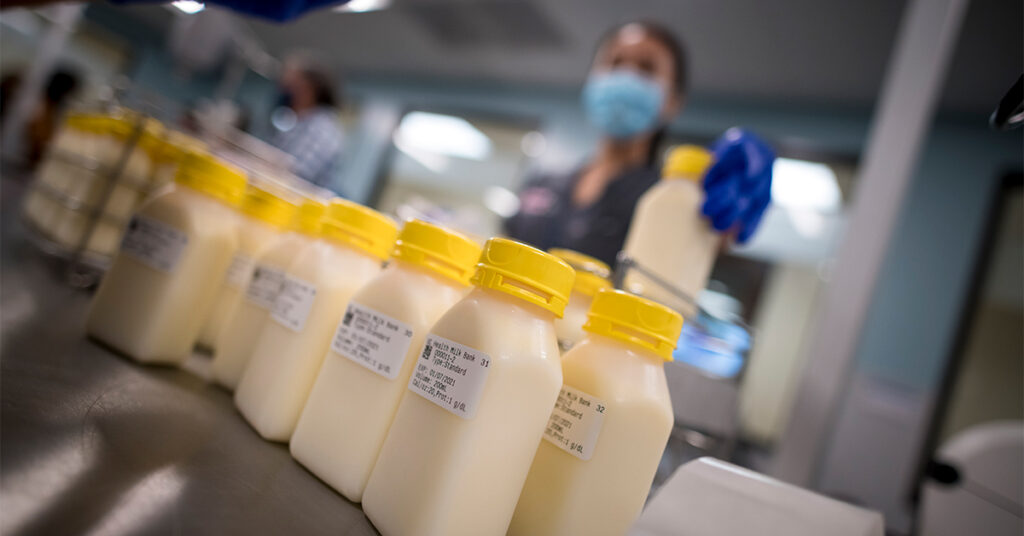Breast milk is a remarkable substance that has evolved over millions of years to provide optimal infant nutrition and protection. Human milk is a complex biological fluid containing a unique blend of carbohydrates, proteins, fats, vitamins, minerals, and bioactive molecules that promote infant growth and development.
In this article, we will explore the biochemistry of human milk, including its composition, nutritional value, and physiological functions. We will also discuss the implications of human milk for infant health and development and compare it to infant formula.
Introduction to Human Milk
Human milk, also known as breast milk, is the natural source of nutrition for human infants. Mammary glands in the breasts of lactating women produce it.
It provides a unique composition of nutrients essential for a newborn baby’s growth and development.

Definition of Human Milk
Human milk is a complex biological fluid that contains various nutrients, including carbohydrates, proteins, fats, vitamins, and minerals.
It is produced by the mammary glands in the breasts of lactating women and is the primary source of nutrition for newborn infants.
Historical Significance of Human Milk
Human milk has been recognized as an essential source of nutrition for infants for thousands of years. In ancient times, human milk was often used to feed orphaned or abandoned babies.
In more recent times, scientific studies have shown that human milk provides numerous benefits for the health and development of babies.
Composition of Human Milk
Human milk is a complex mixture of nutrients uniquely tailored to meet the nutritional needs of a newborn baby. The composition of human milk varies based on the mother’s stage of lactation and the baby’s development.
a. Macronutrient Composition
Human milk contains a balance of carbohydrates, proteins, and fats that is ideal for the growth and development of infants.
Carbohydrates, in the form of lactose, provide energy for the baby. Proteins are essential for growth and development, while fats provide energy and aid in absorbing vitamins and minerals.
b. Overview of the Major Components of Human Milk
In addition to macronutrients, human milk contains vitamins, minerals, and bioactive compounds that provide numerous health benefits for the baby.
These include immune factors, enzymes, hormones, growth factors, and prebiotics.
Proteins in Human Milk
Proteins are an essential component of human milk and play a vital role in the growth and development of newborn infants.
a. Caseins
Caseins are the primary proteins in human milk, making up about 80% of the total protein content. They are essential for the development of the baby’s digestive system and the absorption of calcium.
b. Whey Proteins
Whey proteins are the remaining 20% of the proteins in human milk. They are easily digested and provide essential amino acids for growth and development.
c. Bioactive Proteins in Human Milk
Human milk also contains bioactive proteins such as lactoferrin, lysozyme, and immunoglobulins, which provide numerous health benefits for the baby.
These proteins have antibacterial, anti-inflammatory, and immune-modulating properties.
Carbohydrates in Human Milk
Carbohydrates are the primary energy source in human milk and play an essential role in the growth and development of newborn infants.
a. Lactose
Lactose is the primary carbohydrate in human milk and provides energy for the baby. It also aids in the absorption of calcium and other minerals.
b. Oligosaccharides
- Human milk contains many oligosaccharides, which are complex carbohydrates that the baby does not digest.
- They have prebiotic effects, which promote the growth of beneficial bacteria in the baby’s gut.
c. Other Carbohydrates in Human Milk
Human milk also contains small amounts of other carbohydrates, such as glucose and fructose, which provide additional energy sources for the baby.
Fats in Human Milk
Human milk is rich in fats, which are essential for the growth and development of infants. The lipid composition of human milk varies throughout the lactation period and is influenced by several factors, such as maternal diet, genetics, and metabolic state.
a. Lipid Composition of Human Milk
- Human milk contains various lipid compounds, including triglycerides, phospholipids, cholesterol, and free fatty acids.
- Triglycerides are the most abundant lipids in human milk, accounting for about 98% of the total fat content.
- The fatty acid composition of triglycerides in human milk varies depending on the stage of lactation. In the early stages of lactation, the triglycerides contain more saturated fatty acids, while the triglycerides in mature milk contain more unsaturated fatty acids.
b. Fatty Acid Composition of Human Milk
- Human milk is a rich source of essential fatty acids, including linoleic acid and alpha-linolenic acid, which cannot be synthesized by the human body and must be obtained through the diet.
- These fatty acids are essential for infants’ brain development, vision, and immune function.
- Human milk also contains long-chain polyunsaturated fatty acids such as docosahexaenoic acid (DHA) and arachidonic acid (ARA), which are necessary for brain and eye development.
Vitamins and Minerals in Human Milk
In addition to fats, human milk contains a wide range of vitamins and minerals essential for infant growth and development.
a. Overview of Vitamins and Minerals in Human Milk
- Human milk contains a range of vitamins and minerals, including vitamin A, vitamin D, vitamin E, vitamin K, thiamin, riboflavin, niacin, pyridoxine, folic acid, vitamin B12, vitamin C, calcium, phosphorus, magnesium, iron, zinc, copper, and selenium.
- The concentration of these vitamins and minerals in human milk varies depending on the maternal diet and other factors.
b. Factors Affecting Vitamin and Mineral Content of Human Milk
Various factors such as maternal diet, maternal age, gestational age, and maternal health status can influence the vitamin and mineral content of human milk. For example, maternal vitamin D status can affect the vitamin D content of human milk. Infants exclusively breastfed are at risk of vitamin D deficiency if their mothers do not get enough vitamin D.
Bioactive Molecules in Human Milk
In addition to providing essential nutrients, human milk contains several bioactive molecules that play important roles in infant health and development.
a. Cytokines
Cytokines are small proteins that play an essential role in immune function. Human milk contains a variety of cytokines that can help protect the infant against infections and stimulate immune system development.
b. Growth Factors
Human milk contains a variety of growth factors, including epidermal growth factor (EGF), insulin-like growth factor (IGF), and transforming growth factor-beta (TGF-beta). These growth factors play an essential role in infant growth and development, including developing the digestive and immune systems.
c. Immunoglobulins
Human milk contains a variety of immunoglobulins, including secretory IgA, IgM, and IgG. These immunoglobulins help protect the infant against infections by binding to pathogens and preventing them from infecting the infant.
Implications for Infant Health and Development
Breastfeeding has numerous benefits for infant health and development, and the biochemistry of human milk plays a vital role in these benefits.
a. Breastfeeding Benefits
Breastfeeding has been shown to reduce the risk of numerous infant health problems, including infections, allergies, asthma, and obesity. Breastfeeding also provides numerous benefits for maternal health.
b. Comparison with Infant Formula
While infant formula is designed to provide essential nutrients for infant growth and development, it cannot replicate the complex biochemistry of human milk. Human milk contains numerous bioactive molecules not present in infant formula and cannot be synthesized by the infant’s body.
c. Future Directions in Research
There is still much to learn about the biochemistry of human milk and its implications for infant health and development. Future research may help us better understand the role of specific bioactive molecules in human milk and how they affect infant health.
Frequently Asked Questions (FAQ)
What makes human milk unique?
Human milk is unique because it contains a complex blend of nutrients and bioactive molecules specifically tailored to meet the needs of human infants. Breast milk provides optimal nutrition for infants and helps protect them against a wide range of diseases and infections.
Can infant formula be a suitable alternative to human milk?
Infant formula can be a suitable alternative to human milk for some infants. However, it does not provide all of the unique benefits of human milk, including the complex blend of bioactive molecules that promote infant growth, development, and protection against disease.
What are some factors that can affect the composition of human milk?
The composition of human milk can be affected by a wide range of factors, including maternal diet, maternal health, genetics, and environmental factors. For example, if a mother is malnourished, her milk may contain lower levels of certain nutrients.
What are some of the health benefits associated with breastfeeding?
Breastfeeding provides a wide range of health benefits for both infants and mothers. Breast milk helps protect infants against infections and diseases, reduces the risk of sudden infant death syndrome (SIDS), and may also reduce the risk of certain chronic diseases later in life. For mothers, breastfeeding can reduce the risk of breast and ovarian cancers and may also help promote postpartum weight loss.
In conclusion, human milk is a highly complex and dynamic biological fluid that provides many benefits for infants. The rich array of nutrients and bioactive molecules in human milk play essential roles in infant growth, development, and protection against disease.
Although infant formula is a suitable alternative for some infants, it cannot fully replicate the unique properties of human milk. Further research is needed to fully understand the mechanisms underlying human milk’s benefits and develop new techniques for improving infant nutrition and health.
Discover more from Biochemistry Den
Subscribe to get the latest posts sent to your email.

